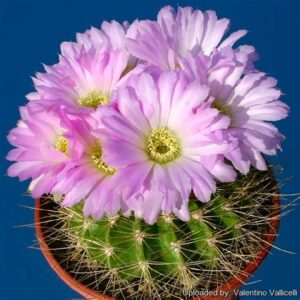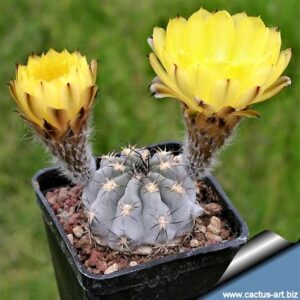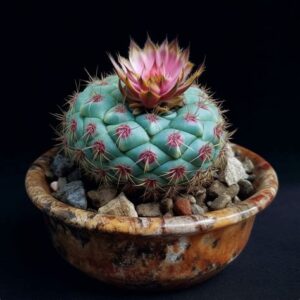In the realm of cacti, few species capture the imagination quite like Acanthocalycium ferrarii. This stunning plant, with its unique attributes and specific cultural demands, is an intriguing specimen for both amateur gardeners and seasoned horticulturists. An exploration of its characteristics and a comprehensive growing guide can illuminate the mysteries surrounding this captivating member of the cactus family.
Hailing from the arid landscapes of South America, particularly Argentina, Acanthocalycium ferrarii is not just another pretty face in the cactus world. With its intricate spines and vibrant blooms, it presents a juxtaposition of resilience and beauty. This article delves into the unique characteristics of Acanthocalycium ferrarii and offers insightful guidance for those keen to cultivate this remarkable plant.
Understanding the specific traits of Acanthocalycium ferrarii enables potential growers to appreciate its aesthetic and functional value. Its appearance is nothing short of extraordinary. This cactus often showcases a cylindrical to globular form, which can reach diameters of up to 10 centimeters when fully mature. The epidermis varies in color from a light green to a bluish hue, creating a visually stunning contrast against the mesmerizing spination.
Its spines, which can range from white to yellow and even reddish-brown, create a textural complexity that attracts the eye. The arrangement of the spines can vary significantly; they can be arranged radially or more clustered, and their arrangement contributes to the plant’s overall visual intrigue. This fascinating spination not only enhances the cactus’s aesthetic appeal but also serves as a crucial adaptation for survival in its native habitat, providing protection against herbivores.
Acanthocalycium ferrarii’s flowering habit is an exciting aspect of its life cycle. The flowers are generally large, funnel-shaped, and can be yellow or orange – dazzling hues that stand in stark contrast to the cactus’s green body. These blooms often emerge in spring or early summer, a time that signifies the plant’s reproductive phase. The flowering period can last up to several weeks, attracting pollinators such as bees and butterflies, thus playing a vital role in the ecosystem.
To cultivate Acanthocalycium ferrarii successfully, it is paramount to mimic the conditions of its natural habitat. Knowing how to recreate the environments allows growers to appreciate this plant’s beauty while ensuring its health and longevity.
First and foremost, soil composition is essential. A well-draining cactus mix, comprised of gritty materials such as pumice or coarse sand, is recommended. The soil should possess a pH level between 6.0 and 7.5 to optimize nutrient availability. Notably, incorporating a bit of organic material can enhance moisture retention without compromising drainage.
Watering is a delicate balancing act. During the active growing season—typically spring and summer—Acanthocalycium ferrarii requires more frequent watering. The soil should be thoroughly soaked and then allowed to dry out completely before the next watering. Overwatering can lead to root rot, a death sentence for many cacti, as their root systems are not designed to cope with excessive moisture. As autumn arrives and the cactus enters dormancy, reduce watering to once every few weeks, allowing the soil to dry out more completely.
Light is another critical factor. Acanthocalycium ferrarii thrives in bright, indirect light. Direct sunlight can be detrimental, especially during the hottest months, potentially leading to sunburn. If grown indoors, placing the cactus near a window that receives filtered sunlight is ideal. In contrast, outdoor cultivation in a semi-shaded area can yield splendid results, capturing the richness of natural sunlight while protecting the plant from the harshest rays.
Fertilization plays a pivotal role in supporting the growth and flowering of Acanthocalycium ferrarii. Monthly applications of a diluted, balanced fertilizer during the growing season can enhance the plant’s vigor and promote abundant blooms. Opt for fertilizers specific to cacti and succulents; these are generally lower in nitrogen and higher in potassium and phosphorus, which are crucial for flowering plants.
Pest management should not be overlooked. Although Acanthocalycium ferrarii is relatively resistant to pests, it is not immune. Common pests such as mealybugs and spider mites can occasionally infiltrate your cactus. Regularly inspecting the cactus and maintaining good air circulation can mitigate these issues. For any infestations, a diluted soap solution or neem oil can be effective treatments.
The propagation of Acanthocalycium ferrarii is often pursued by those who find this stunning cactus compelling enough to share with others. There are two primary methods for propagation: from seeds or offset colonies. The seed method requires patience, as seeds typically take longer to germinate. Sow seeds in a well-draining mix and maintain a warm environment with indirect light.
Offsets can be removed from the mother plant and planted separately, allowing for quicker reproduction. This method is usually more successful and preferred by many gardeners, especially those with less experience. After careful removal, allow the offsets to dry and callous over for a few days before planting them to prevent rot.
Acanthocalycium ferrarii is notable for its compelling ability to adapt within its limited geographical range. Known to thrive in arid conditions, this cactus has evolved mechanisms to withstand extreme temperature fluctuations and prolonged periods of drought. Growers can derive inspiration from the plant’s resilience. It serves as a reminder of the natural world’s tenacity and the beauty that can emerge from challenging environments.
For those prepared to engage with the intricacies of Acanthocalycium ferrarii, the rewards are manifold. This cactus is not merely an attractive addition to a collection; it embodies the allure of the unpredictable botanical realm. The engagement with this remarkable species promises a shift in perspective towards patience, precision, and an appreciation for nature’s subtle, yet profound, complexities.
In conclusion, Acanthocalycium ferrarii exemplifies the delicate interplay of form, function, and beauty in the world of cacti. Its unique characteristics and the thoughtful care it demands can establish a rewarding connection between grower and plant. Cultivating this species invites not only an appreciation for its aesthetic qualities but also an understanding of the intricate balance required for its survival. Whether you are drawn to its striking appearance or its fascinating adaptation to arid environments, Acanthocalycium ferrarii remains a compelling choice for anyone seeking to explore the world of cacti.





Leave a Comment